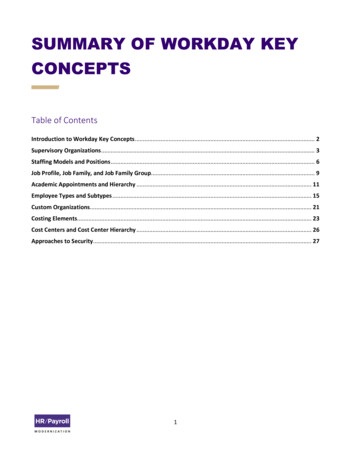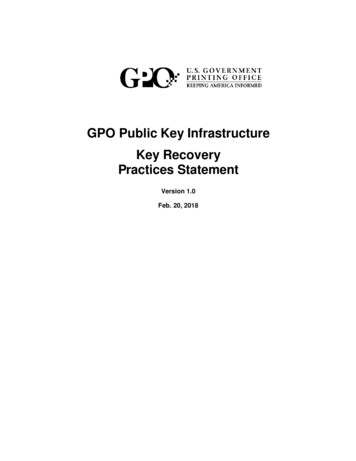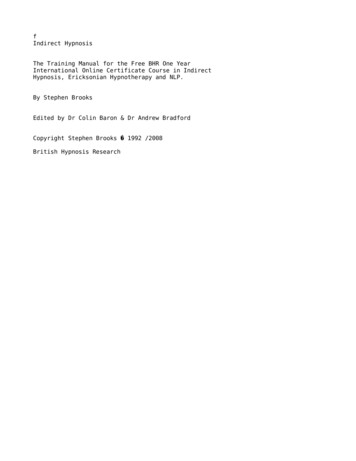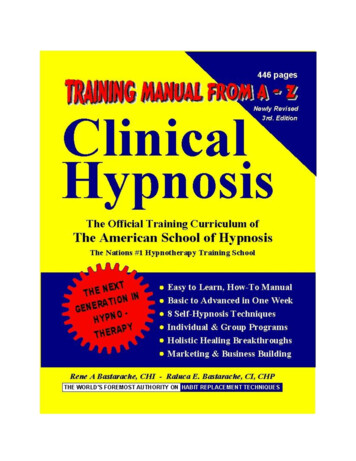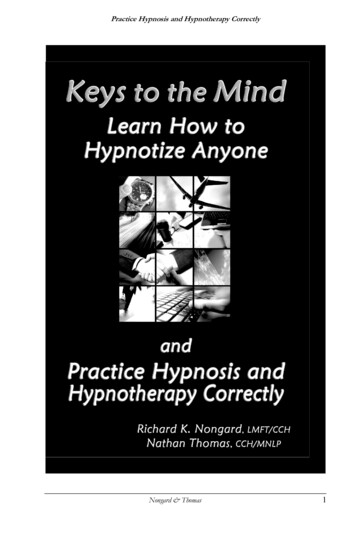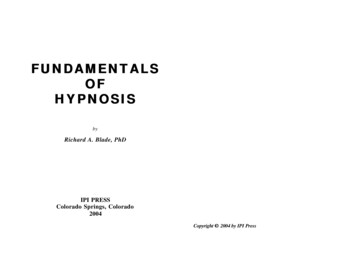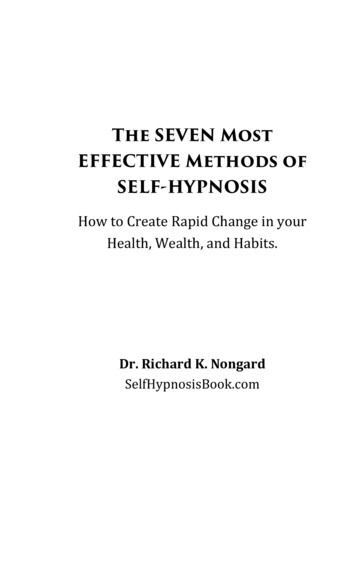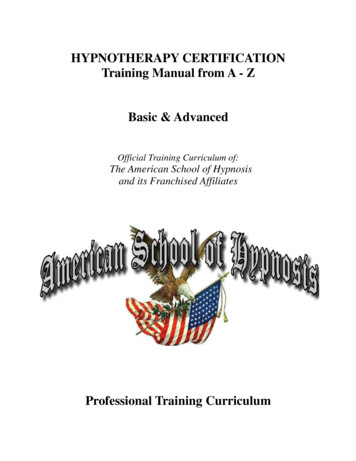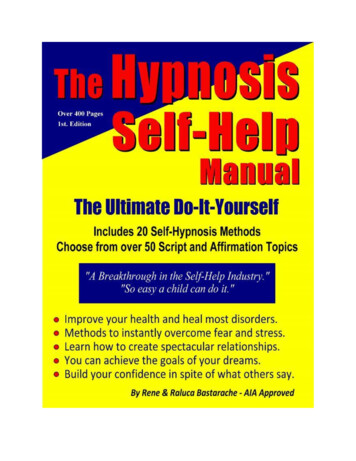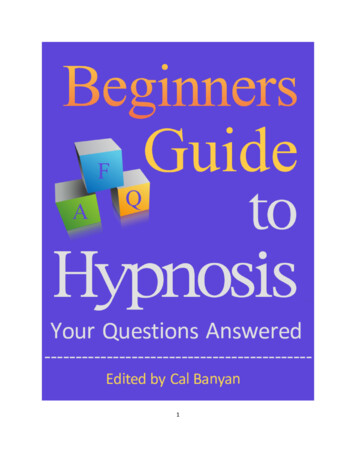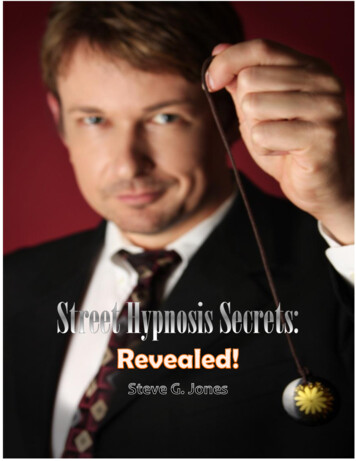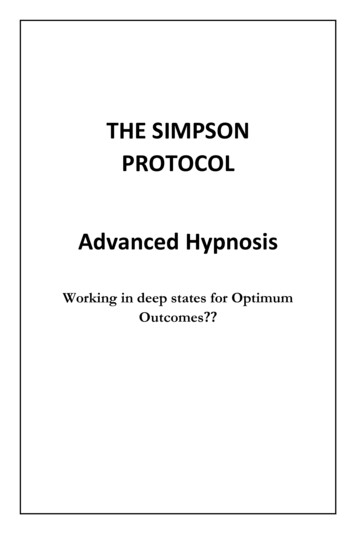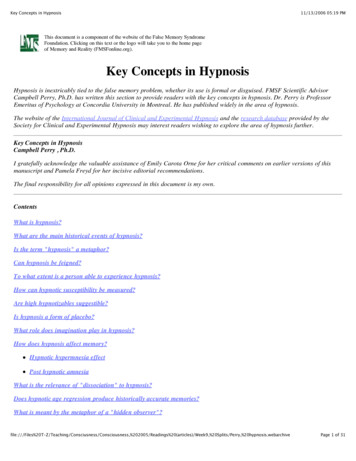
Transcription
Key Concepts in Hypnosis11/13/2006 05:19 PMThis document is a component of the website of the False Memory SyndromeFoundation. Clicking on this text or the logo will take you to the home pageof Memory and Reality (FMSFonline.org).Key Concepts in HypnosisHypnosis is inextricably tied to the false memory problem, whether its use is formal or disguised. FMSF Scientific AdvisorCampbell Perry, Ph.D. has written this section to provide readers with the key concepts in hypnosis. Dr. Perry is ProfessorEmeritus of Psychology at Concordia University in Montreal. He has published widely in the area of hypnosis.The website of the International Journal of Clinical and Experimental Hypnosis and the research database provided by theSociety for Clinical and Experimental Hypnosis may interest readers wishing to explore the area of hypnosis further.Key Concepts in HypnosisCampbell Perry , Ph.D.I gratefully acknowledge the valuable assistance of Emily Carota Orne for her critical comments on earlier versions of thismanuscript and Pamela Freyd for her incisive editorial recommendations.The final responsibility for all opinions expressed in this document is my own.ContentsWhat is hypnosis?What are the main historical events of hypnosis?Is the term "hypnosis" a metaphor?Can hypnosis be feigned?To what extent is a person able to experience hypnosis?How can hypnotic susceptibility be measured?Are high hypnotizables suggestible?Is hypnosis a form of placebo?What role does imagination play in hypnosis?How does hypnosis affect memory?Hypnotic hypermnesia effectPost hypnotic amnesiaWhat is the relevance of "dissociation" to hypnosis?Does hypnotic age regression produce historically accurate memories?What is meant by the metaphor of a "hidden 9,%20Splits/Perry,%20hypnosis.webarchivePage 1 of 31
Key Concepts in Hypnosis11/13/2006 05:19 PMWhat is the connection between Hypnosis and Multiple Personality Disorder (MPD) [recently renamed as DissociatedIdentity Disorder (DID)]?History and Frequency of MPD/DIDIatrogenic MPD/DIDSimulation of MPD/DIDIs sexual abuse during childhood a cause of MPD/DID?What is the role of hypnosis in the creation of false memories?What is the difference between formal and "disguised" hypnosis?Can hypnosis be dangerous?Gail Macdonald's storyFMSF legal surveyConclusionCan a hypnotized person be coerced into unconsenting acts?How is hypnosis used in entertainment, therapeutic, and forensic contexts?Stage hypnosisTherapeutic hypnosisForensic hypnosisWhat are some of the clinical successes and failures with hypnosis?What are some current controversies in hypnosis?How can a person find a qualified clinical practitioner of hypnosis?What are the main professional hypnosis societies?What are the main scientific journals of hypnosis?ReferencesWhat is hypnosis?Hypnosis involves a person's ability to set aside critical judgment without relinquishing it completely, and to engage in makebelieve and fantasy (Gill & Brenman, 1959; E. R. Hilgard, 1977). For some people this make-believe may be so vivid andintense that they have trouble differentiating it from reality. Indeed, they may not be able to do so. It should be emphasized thatthe experience of hypnosis has very little to do with the abilities of the hypnotist, and is mainly a matter of abilities of theperson hypnotized. The ability to conduct a hypnotic induction is acquired easily and rapidly by an individual who has at leastmoderate interpersonal skills, and who is able to establish a relationship of trust and an appearance of competence.Hypnosis in itself is not a science; its phenomena, though, have proven to be highly amenable to experimental researchemploying the methodology and procedures of scientific enquiry. The ability to hypnotize does not qualify a person to treatothers; for that, a post-graduate degree in psychiatry or clinical psychology allied to a solid grounding in hypnotic ,%20Splits/Perry,%20hypnosis.webarchivePage 2 of 31
Key Concepts in Hypnosis11/13/2006 05:19 PMare required. Some more detailed suggestions are provided in the section called How can a person find a qualified clinicalpractitioner of hypnosis?What are the main historical events of hypnosis?Hypnosis has a long and rich history (Gauld, 1992; Laurence & Perry, 1988), dating from the late 18th Century in Paris.During that period, Franz Anton Mesmer gained astonishing popular recognition for what he called Animal Magnetism (thefirst of several metaphors for what is now called hypnosis). Mesmer believed that there is an invisible animal magnetic force orfluid in the atmosphere which he could harness, store in his body, and transmit to physically ill patients with curative effects.What is remarkable about Mesmer is that although the historical records of his practice are not always clear, Mesmer obtainedmajor improvements and occasionally complete cures that other medical professionals of his epoch were not able to obtain.This success led him to conclude, erroneously, that Animal Magnetism exists; we now know, however, that the various nonspecific placebo factors that are present in healing situations may have been the effective ingredients in his treatmentsuccesses. Elements such as hope for a cure or alleviation and faith and trust in the magnetist, and in magnetism, are all likelyto have weighed in, just as they do in a variety of healing contexts today.In 1784, A Royal Commission of Inquiry into Animal Magnetism was established. It was headed by Benjamin Franklin, andincluded some of the leading scientists of the day such as Lavoisier, the chemist, and Guillotine, the inventor. It performedsome quite sophisticated experiments on magnetic phenomena. With the magnetically "adept" person separated from themagnetist by a paper screen so that they could not see each other, the Commissioners found that the patient frequently showedmagnetic effects when the magnetist was not magnetizing, and did not show these effects on other occasions when he was. TheCommission concluded (correctly) that animal magnetism did not exist, and (incorrectly) that its non-existence meant that itcould not have curative effects.In the true traditions of science, however, the commission provided an alternative explanation of magnetic phenomena, part ofwhich suggested a way in which an ostensibly non-existent entity could, in fact, have curative effects. It concluded that theeffects observed were the product of imagination, imitation and touch, and that the main contributing factor was imagination.As will be seen later, imagination still has considerable currency in much theorizing about hypnosis; it is now consideredcentral to understanding the manner in which hypnosis quite often alleviates a variety of medical difficulties, in situations suchas clinical pain, where drugs and/or surgery have been ineffective (Melzack & Perry, 1975).Two other investigators of this period made significant contributions to the understanding of what is now called hypnosis. TheMarquis de Puysegur renamed it artificial somnambulism, and placed much emphasis on the notion that magnetic phenomenawere most likely to be elicited under conditions of what he called "exclusive rapport" between hypnotist and hypnotizedperson. The Abbe Jose Custodia di Faria called it lucid sleep, and drew attention to the observation that between 16-20% ofthe population was highly responsive to it (an estimate not unlike current data on high levels of hypnotic responsivity). Others,including Mesmer, had reported on the differential nature of response to what is now known as hypnosis, but Faria was thefirst to emphasize it and to make it the cornerstone of his position.The term "hypnosis" was coined by James Braid, a Manchester surgeon, in his book of 1843. Here he was following the sleepmetaphors proposed by Puysegur and Faria, since the term comes from the Greek hypnosis: to sleep. At a superficial level, thisis a plausible deduction given that, as Faria observed, such phenomena as sleep walking and talking appear to be duplicated inhypnosis. It was not until the 1950s, with the advent of the technology of the electroencephalogram (EEG) that the sleepmetaphor was discarded. The EEG of hypnosis is formally indistinguishable from a pattern of being relaxed, alert with eyesclosed. By contrast, the EEG of sleep consists of four distinct polygraph defined stages that run in approximately 90-minutecycles of progressively less depth throughout the night (Aserinsky & Kleitman, 1953).For much of the 19th Century, another view of hypnosis gradually took hold. This is the belief that hypnosis is a matter of aperson's degree of suggestibility. Unfortunately, this particular conceptualization carries pejorative overtones, implying thatresponse to hypnosis is a matter of gullibility and/or feeble will. Suggestibility theory makes little logical sense, being basedupon the observation that because a person responds to a number of suggestions, s/he must be suggestible.The sleep metaphor came to be reconciled, to a degree, with suggestibility theory in the latter part of the 19th Century inFrance. A.A. Liebeault saw hypnosis as "artificial sleep" and as indistinguishable from nocturnal sleep. He also viewedsuggestion as essential in actuating the hypnotic process, in which the hypnotized person became an automaton, unable its/Perry,%20hypnosis.webarchivePage 3 of 31
Key Concepts in Hypnosis11/13/2006 05:19 PMresist the demands of the hypnotist.Towards the end of the 19th Century, two "schools" of hypnosis emerged in France. Each had views that were frequentlyopposed diametrically. Hippolyte Bernheim, much influenced by Liebeault, headed a "school" at the University of Nancy, andargued that hypnosis was initiated by suggestion and explained by suggestibility. By contrast, Jean-Martin Charcot at LaSalpetriere Hospital in Paris, one of the foremost neurologists of his day, argued that hypnosis is a physio-pathologicalcondition allied to hysteria. At around this time, legal cases involving evidence derived from hypnosis began to be heard byFrench courts, and both Charcot and Bernheim became deeply involved in the controversy that these legal proceedingsgenerated.The effect of these legal battles for the study of hypnosis was disastrous in the short term. Not only did Charcot and Bernheimhold almost diametrically opposed views on many issues; both, also, were in error on some of them. Professional interest inhypnosis waned towards the beginning of the 20th Century, as people in the field turned away from this corrosive legal battle,and towards the distinctive views and approach of Sigmund Freud.For the first three decades of the 20th Century, interest in hypnosis remained in decline, only to be revived by Clark L. Hull,whose 1933 book entitled Hypnosis and suggestibility: An experimental approach was instrumental in rekindling interest in thetopic. This renewal of interest was short-lived, however; Hull was forced to abandon the study of hypnosis and to turn hisattention to learning theory. Two apocryphal stories exist on why this happened. One is a misguided concern that hypnosisthreatened the chastities of female students at his university. An alternative account is that a student who was working at Hull'slab hypnotized another student, but did not evaluate post-hypnosis alertness. The student left and was hit by a car whilecrossing the street. The parents threatened to sue Yale University (or did sue it) and the lab was closed. Whatever the reason,the field of hypnosis lost one of its most talented and prolific researchers at a time when it could least afford it.World War II, however, provided an unexpected reprieve. In the heat of battle, field hospitals often ran short of the drugsneeded to treat wounded soldiers. Under often appalling conditions, a small group of clinicians of hypnosis were able toprovide pain relief and alleviation of the suffering of their often severely injured patient. Some of these clinicians bandedtogether after the war ended to form the Society for Clinical and Experimental Hypnosis (SCEH); it held its first meeting in1949. Unfortunately, as a result of some major disputes on clinical issues within SCEH, some clinicians, spearheaded byMilton Erickson, went on to form the American Society of Clinical Hypnosis (ASCH) in 1957.The period between 1960 and 1990 is likely to be seen by future historians as halcyon days for hypnosis. During this period,three major hypnosis research laboratories developed in the United States. One was at Stanford University under the directionof Ernest and Josephine Hilgard. A second one was at the University of Pennsylvania (after a brief inaugural period atHarvard University) under the guidance of Martin T. Orne, Emily Carota Orne and (in later years) David F. Dinges. A thirdone was at Medfield Hospital in Massachusetts under the auspices of Theodore C. Barber. Unfortunately, the Stanford andMedfield laboratories are no more; by contrast the Philadelphia Laboratory continues to thrive.These three laboratories had a profound effect on younger clinicians and researchers who entered the field of hypnosis duringthis period; indeed, many of them received some of their doctoral and/or post-doctoral training at either Stanford,Pennsylvania or Medfield. In addition, strong national societies of hypnosis sprang up in many countries, and, gradually, someinternational structures to link them. With the ease and speed of travel provided by the aviation industry, the study of hypnosisbecame international in a manner hitherto not envisaged. The upshot of these developments is that, for future investigators ofthe 21st Century, there exists a solid empirical, cl
Hypnosis involves a person's ability to set aside critical judgment without relinquishing it completely, and to engage in make- believe and fantasy (Gill & Brenman
